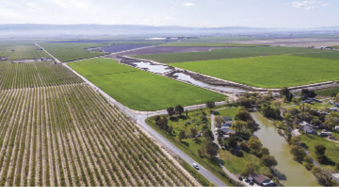California needs housing, but must protect its farms


By Kara Heckert
Severe drought is leading California’s farmers and ranchers to fallow lands, switch to less water-intensive crops, or farm on fewer acres. Cattle producers, whose pastures are nearly barren, are selling off cattle because they have little or nothing to feed them.
In 2021, 395,100 acres of cropland were fallowed, which resulted in more than 14,000 lost jobs and $1.7 billion in lost revenue, according to the California Farm Water Coalition. It predicts this year will be worse, with 594,000 to 691,000 fallowed acres, up to 25,800 lost jobs and $3.5 billion in lost economic output.
Current development trends are sounding off additional alarms for the loss of productive farmlands.
According to American Farmland Trust’s new report “Farms Under Threat, Choosing an Abundant Future,” California ranks fifth in the nation for projected agricultural land conversion to nonfarming uses by 2040. Some 797,400 acres may potentially be idled, much of it paved over for residential, commercial or industrial development under a troublesome business-as-usual scenario.
In fact, three of the top 20 counties nationally in farmland acreage loss are in California, including Riverside (second in the nation), San Bernardino (12th) and Fresno (17th). Other notable counties include Kern (29th), Los Angeles (30th) and San Diego (36th).
Particularly alarming is Fresno County. According to the 2020 Fresno County Crop Report, Fresno is the nation’s No. 1 agricultural county. It is home to1.88 million acres producing more than 350 different crops, contributing billions of dollars to California’s economy and supporting 20% of all jobs in the Fresno area.
To see how quickly a valuable agricultural region can disappear, we need look only to the not-so-distant history of Southern California. Los Angeles County “was once the largest, most bountiful agricultural county in the U.S. (for four decades, between 1909-1949). It’s now primarily urban and is the most populated county in the nation,” explains University of California’s Rachel Surls, co-author of “From Cows to Concrete: The Rise and Fall of Farming in Los Angeles.”
In an interview with Dr. Rose Hayden-Smith, Surls described how the transition sped up after World War II, when the nation needed more affordable housing.
But California’s agricultural land loss means less land to provide the bounty of food and fiber to the rest of the United States and the world. It means less prime agricultural land to provide a carbon sink, groundwater recharge, riparian buffers for fish and wildlife, and scenic viewsheds for all. Not to mention, the loss of farmland means a devastating impact on our local and state economies.
There is no question that creating new housing is critical. The state needs millions of units of affordable and “climate-friendly” housing, Gov. Gavin Newson declared in a recently posted letter to the California Air Resources Board on California’s Climate Commitment.
But California can both provide housing and protect as much of California’s irreplaceable agricultural resources as possible. American Farmland Trust’s report lays out three future development scenarios: runaway sprawl; business as usual; and better built cities.
AFT promotes the “better built cities” scenario for clear reasons. It envisions successful efforts to reduce the footprint of residential, commercial and industrial development on productive agricultural land. While the scenario still results in conversion of some agricultural land, it envisions a future with vibrant, compact cities and towns, and abundant farm and ranch land to meet future needs.
By choosing the “better built cities” scenario instead of “runaway sprawl,” Californians can save 413,200 acres of farmland and ranchland. That means saving 2,805 farms, preserving $545 million in farm output and keeping 7,124 jobs.
We know planners need support to protect our agricultural resources with the greatest potential to effectively infiltrate and conserve water during this historic drought.
That’s why AFT and Conservation Biology Institute created the Project Prioritization Tool, based on data analysis of the San Joaquin Valley Land and Water Strategy Report. This conservation decision-making tool helps increase adoption of water infiltration practices, improves groundwater recharge and protects agricultural land in San Joaquin Valley, and it may soon be used across the state.
Unfortunately, California hasn’t increased its investment in agricultural land protection, despite historic state budget surpluses. The Golden State’s per-capita investment is 11 cents, while Delaware’s investment is $6.03, according to Farms Under Threat research from 2020.
The decisions our California communities make now with respect to managing housing density and urban growth are critical for our future. It is essential that we accommodate additional population increases without compromising still more important agricultural land and open space. California agriculture—and America’s food supply—depends on it.
(Kara Heckert is the Resilient Agriculture West advisor and former California regional director for the American Farmland Trust. She may be contacted at kheckert@farmland.org.)




